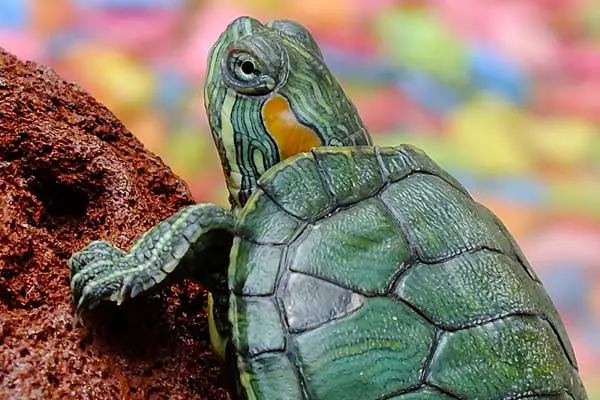Some people with turtles for pets become very worried when they notice their turtle has changed colors from pictures taken years ago. Most of the time, there is nothing to worry about! Yes, turtles change colors, but it is not random.
Turtles’ colors can change colors for a multitude of specific reasons:
- Males can change their color to increase their visibility to the opposite sex.
- Turtles may also gradually change their color to adapt to a new environment.
- They can change colors when they are out in the sun too long and get faded and dehydrated.
- Turtles change colors as they age.
- Finally, the turtle can change colors simply because it needs to be cleaned.
The one caveat to this is that there could be something wrong with your turtle if they are not getting enough UV light. Thankfully, this can be easily corrected.
UV Light
A turtle’s body will discolor if it doesn’t receive adequate heat or light. To solve this, move your turtle tank to a window or section of your living quarters where plenty of natural light is coming in every day.
It would help if you utilized UV lights when there isn’t enough sunlight, such as at night and during the darker seasons.
Make sure to select a UV bulb that is of high quality, emits UV-B light, and is long-lasting.
For your turtle to receive enough UV light throughout the winter, you typically need to light UV lamps for 10 to 12 hours a day.
Algae and Dirt Buildup
One reason turtles can ‘change colors’ is because they are dirty. Over time, dirt, algae, and other materials from the earth can build up on a turtle’s shell and other parts of its body.
If you have a turtle, it is essential to clean it regularly but not overdo it or use the wrong materials. Bathing your turtle can help their shell health and keep them from dehydrating. Do not use soap! Dish soap is not safe for turtles.
The chemicals in the soap can cause inflammation on a turtle’s skin. Brushing and water are enough to keep a turtle clean.
In particular cases, a veterinarian can give shampoo to a turtle with a specific medical condition, but that is it.
You’ll want to boil the water and then let it cool off before bathing a turtle so that the water is clean and disease-free. If it is lukewarm, it will be okay.
While a turtle’s shell is quite hard, that does not mean that the turtle cannot feel when you press and rub on its shell. They can feel the vibrations, which brush on their skin, so it is essential not to press or scrub too hard.
Use a soft brush or sponge to clean thoroughly but softly to remove loose dirt and algae. Their skin is also sensitive, so don’t push too hard anywhere.
Please do not turn the turtle upside down when lifting them, or it could feel to them like they are suffocating. Turtles do not like being turned on their backs. When cleaning underneath them, lift them so you can see. There is no need to flip them over.
Once your turtle dries, it will look like they have changed color because of the dirt and moss being cleaned off. They will likely look brighter and stand out more in the scenery.
Seasons
Turtles do change colors during different seasons. However, this change is barely noticeable to the eyes of humans. Turtles have a better eye for color and can see their fellow turtles’ differences.
The male turtles brighten their colors, specifically orange, yellow, and red, to attract females. Female turtles are pretty sensitive to light and can detect these changes.
Aging
As it ages, a turtle’s shell will go from brighter to darker shades. Many turtles have a light green hue when they are young, slowly becoming darker as they enter their elder years.
The degree of how much they change depends mainly on the species of the turtle because, in certain species, the change in hue is much more noticeable.
If your turtle has gotten darker the longer you have had them; it is not causing panic. Turtles’ changing colors is a normal phenomenon and another reason to love those beautiful creatures.
Same species
Turtles from the same species often have various hues and complexities in their colors. Specific subspecies of turtles have distinctions in their color pattern and brightness.
Additionally, turtles of the same subspecies can still have different colors because they may attempt to mate during mating seasons or blend in more with their environment.
Albino Turtles
Albino turtles are pretty rare, but they do exist. These turtles lack pigmentation in both their skin and shells. They are not just totally white, as the albino name might suggest, but everything on them is lighter.
It depends on the breed of the turtle. The skin is often white with some yellow pigmentation throughout, and the shell looks a faded yellow. However, some albino turtles are almost entirely white.
For tortoises, only about one in one hundred thousand is born albino. Unfortunately, few survive in the wild and have difficulty even making it out of the nest. Their colors do not fit in well with their environment, and sometimes they have other health issues that accompany their condition.
If your turtle is changing colors, there is no reason to panic. Turtles changing colors can be a cool thing and is just another example of what amazing creatures they are.
Their color changing is likely either a natural phenomenon or can be corrected by a few simple tasks on your part.
Make sure your turtle is being cleaned regularly and getting adequate UV light. Feed it a good diet and love it with all your heart; it will be okay!
